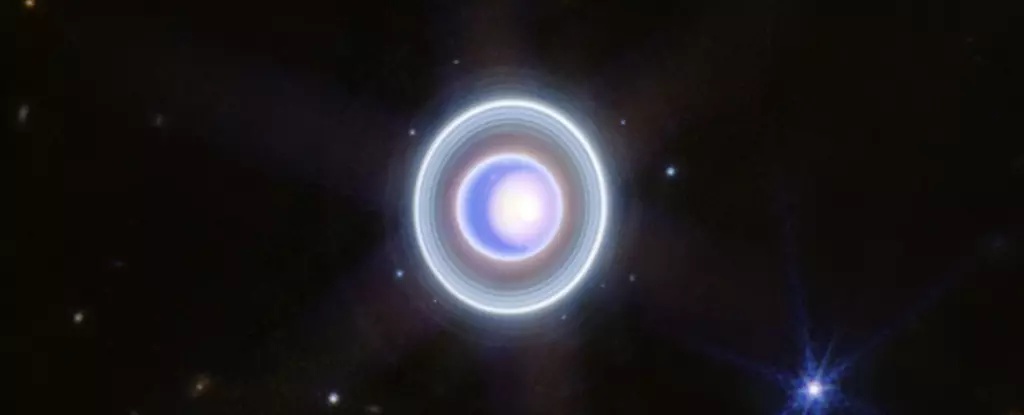For many years, Uranus has held a unique position among the planets of our Solar System, characterized by its peculiar attributes and enigmatic behavior. The magnetic field of Uranus has long been a conundrum for scientists, primarily based on data collected from NASA’s Voyager 2 during its historic flyby in 1986. This imaginative mission, while groundbreaking, may have provided an incomplete picture of the planet’s magnetic characteristics. Recent research led by NASA’s Jamie Jasinski suggests that the unusual observations made during this flyby may have resulted from temporary conditions rather than a consistent state of the planet’s magnetic environment.
When Voyager 2 approached Uranus, it provided the first and, to date, only direct measurements of the planet and its surrounding magnetic field. During this brief five-day encounter, scientists were stunned to find that Uranus’s magnetosphere appeared drastically different from those of other planets, exhibiting chaotic behavior and irregularities that baffled astronomers. This unexpected discovery led to the prevailing narrative that Uranus has a uniquely chaotic magnetic field, leading to alternative theories about its interior structure and behavior.
However, Jasinski argues that these observations may not reflect the typical state of Uranus. Upon examining solar wind data in conjunction with the Voyager 2 findings, he noted a significant spike in solar activity before the spacecraft’s flyby. This constructive correlation indicates that the magnetosphere was abnormally compressed, creating atypical conditions that influenced the data captured during the encounter.
Solar winds, essentially streams of charged particles released from the sun, greatly influence the magnetospheres of planets. Jasinski’s research highlights that just before Voyager 2’s visit, the solar wind pressure around Uranus soared to unprecedented levels, pushing the planet’s magnetosphere down to merely 20% of its usual volume. This phenomenon induced a distortion in Uranus’s magnetic field measurements, suggesting that the exceptional conditions outweighed the planet’s normal magnetospheric behavior.
What makes this revelation vital is that it invites scientists to reconsider their long-held views on the information gleaned from the Voyager mission. With the dynamic nature of space weather and solar activity, observations of Uranus could have been affected in ways previously overlooked. The implications extend beyond Uranus’s magnetic field; the distortion may have inhibited detection of atmospheric phenomena and interactions involving Uranus’s moons, further complicating the planet’s scientific narrative.
The revelation that Uranus’s odd magnetic readings could be a product of environmental anomalies challenges earlier assumptions that its magnetic field system is inherently different from other gas giants like Jupiter and Saturn. Instead of viewing Uranus through a lens of singularity, scientists may need to adopt a more nuanced understanding predicated on the idea that it can experience transient states analogous to other planetary bodies in the Solar System.
The importance of revisiting these conclusions cannot be overstated. As Jasinski notes, this paradigm shift could ultimately necessitate a reevaluation of theories regarding the electrical and magnetic properties of not only Uranus but also its atmospheric and geological compositions. Furthermore, it emphasizes the necessity for additional exploratory missions targeting both Uranus and Neptune, as a follow-up initiative to gather more comprehensive data over varied space weather conditions.
The intricate dynamics of Uranus have propelled calls for renewed exploration of this distant planet along with its intriguing system of moons. Equipped with more sophisticated instruments and technology, a dedicated mission could address the shortcomings of the Voyager 2 encounter, enabling scientists to understand the planet’s features under diverse solar conditions. Such initiatives could illuminate the ways in which solar winds shape Uranus’s magnetosphere, providing a clearer picture of its internal structure and the interactions at play.
Jasinski’s insights exemplify the value of scrutinizing past data with fresh perspectives, as they may unlock more profound mysteries about Uranus. This planetary puzzle, like so many others, mirrors the complexity of the universe itself, continually inspiring scientists to dive deeper into space exploration. As our understanding evolves, so too will our appreciation of the cosmic environment that governs the planets in our Solar System, with Uranus as a compelling subject of study.


Leave a Reply